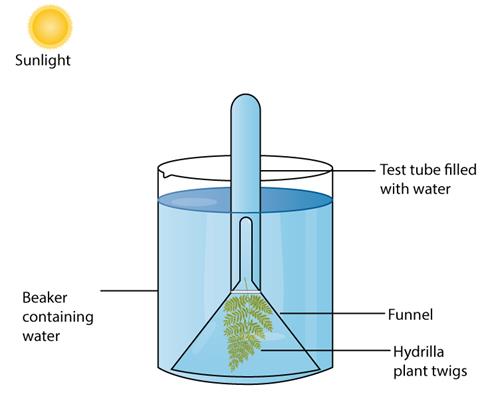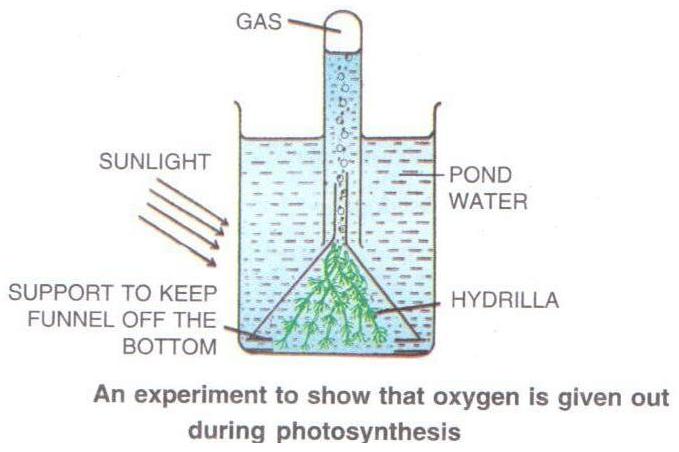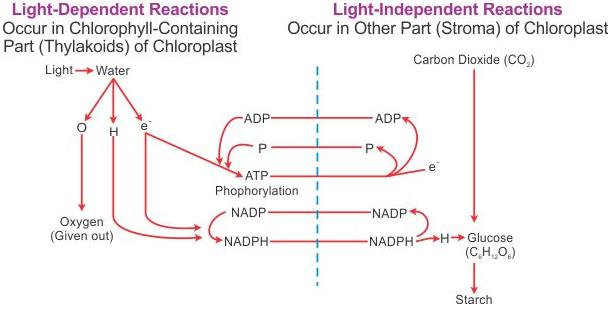Class 10 SELINA Solutions Biology Chapter 6 - Photosynthesis
Photosynthesis Exercise Ex. 1
Solution A.1
(b) Thylakoid
Solution A.2
(c) Carbon dioxide is evolved
Solution A.3
(b) Green
Solution A.4
(d) Photon
Solution A.5
(c) Photolysis
Solution A.6
(d) Thylakoids
Solution A.7
(b) Methylated spirit
Solution A.8
(a) Carbon dioxide
Solution A.9
(d) 35°C
Solution A.10
(c) Polymerisation
Solution B.1
(a) Producers / Autotrophs
(b) Chloroplasts
(c) ATP (Adenosine triphosphate)
(d) Glucose
(e) Carbon dioxide dissolved in water
(f) Stroma
Solution B.2
(a) Chlorophyll : Magnesium :: Haemoglobin : Iron
(b) Light reaction : Granum :: Dark reaction : Stroma
(c) Producers : Autotrophs :: Consumers : Heterotrophs
(d) Respiration : Carbon dioxide :: Photosynthesis : Oxygen
(e) Water and minerals : Xylem :: Prepared food : Phloem
Solution C.1
(a) False
Correct Statement: Dark reaction of photosynthesis is independent of light and occurs simultaneously with light reaction.
(b) True
(c) False
Correct Statement: Green plants are producers.
(d) False
Correct Statement: Respiration results in loss of dry weight of the plants.
(e) False
Correct Statement: Photosynthesis stops at a temperature of above 40oC.
(f) True
(g) True
(h) True
Solution C.2
(a) The site of light reaction in the cells of a leaf is grana.
(b) The chemical substance used to test the presence of starch in the cell of a leaf is iodine solution.
(c) Stroma is ground substance in chloroplast.
(d) The dark reaction of photosynthesis is known as Calvin cycle.
(e) In the flowering plants, food is transported in the form of sucrose.
Solution C.3
(a) False
Photosynthesis increases with the light intensity up to a certain limit only and then it gets stabilized.
(b) False
The atmospheric temperature is an important external factor affecting photosynthesis. The rate of photosynthesis increases up to the temperature 35oC after which the rate falls and the photosynthesis stops after 40oC.
(c) False
Ice cold water will hamper the process of photosynthesis in the immersed leaf, even if there is sufficient sunshine because the temperature is an important factor for the rate of photosynthesis.
(d) False
For destarching, the potted plant can kept in a dark room for 24-48 hours.
(e) False
If a plant is kept in bright light all the 24 hours for a few days, the dark reaction (biosynthetic phase) will continue to occur because the dark reaction is independent of light and it occurs simultaneously with the light dependent reaction.
(f) True
Solution C.4
Photons, grana, water molecules, hydrogen and hydroxyl ions, oxygen
Solution C.5
Differences between photosynthesis and respiration: (Any 4)
|
Photosynthesis |
Respiration |
|
|
|
|
|
|
|
|
|
|
Solution C.6
(i) Grass → Rabbit → Snake → Hawk
(ii) Grass/Corn → Mouse → Snake → Peacock
Solution C.7
(a) Hydrilla and Elodea
(b) Coleus and Croton
(c) Carbon dioxide and water
(d) Water, carbon dioxide, sunlight and chlorophyll
(e) Light-dependent phase (photo-chemical phase) and light independent (dark) phase (biosynthetic phase)
Solution C.8
|
Column A |
Column B |
|
(a) Chlorophyll |
(iii) Traps solar energy |
|
(b) Methylated spirit |
(v) Bleaches chlorophyll |
|
(c) Potassium hydroxide |
(i) Removes/absorbs CO2 |
|
(d) Iodine solution |
(ii) Tests presence of starch |
|
(e) Water |
(iv) Produces oxygen |
Solution C.9
To test the leaf for starch, the leaf is boiled in water to kill the cells (1). It is next boiled in methylated spirit to remove chlorophyll (2). The leaf is placed in warm water to soften it. It is then placed in a dish and iodine (3) solution is added. The region, which contains starch, turns blue-black (4) and the region, which does not contain starch, turns brown (5).
Solution C.10
(a) Chlorophyll: It is contained in the walls of the thylakoids.
(b) Chloroplast in the parts of a plant: They are contained in the cytoplasm of a plant cell.
(c) Stroma: It occurs as a ground substance in chloroplast.
(d) Guard cells: They are found surrounding the stomata in the leaf epidermis.
(e) Palisade cells: They are situated in the upper mesophyll region of a leaf.
Solution D.1
(a) Photosynthesis: Photosynthesis is the process by which living plant cells, containing chlorophyll, produce food substances (glucose and starch), from carbon dioxide and water, by using light energy and release oxygen as a by-product.
(b) Thylakoids: Closely packed flattened sacs arranged in piles in the interior of chloroplasts are called thylakoids.
(c) Chloroplast: Chloroplasts are minute oval bodies bounded by a double membrane which contains thylakoids arranged in piles called grana lying in a colourless ground substance called stroma.
(d) Photolysis of water: Photolysis of water is defined as the splitting of H2O molecules into hydrogen ions and oxygen in the presence of light.
(e) Polymerisation: Polymerisation is the process in which several glucose molecules are transformed to produce one molecule of starch.
Solution D.2
(a) The objective of this experiment is to show that sunlight is necessary for photosynthesis.
(b) The process shown here is photosynthesis. Photosynthesis is the process by which living plant cells, containing chlorophyll, produce food in the form of glucose and starch, from carbon dioxide and water, by using light energy.
(c) Destarching removes all the starch from the leaves and stores it in the storage organs of the plant. This makes the leaves free of starch. The starch produced during the experiment can thus be measured accurately. If destarching is not done, the already present starch in the leaves may interfere with the actual experimental observations and show false results. Hence, in order to obtain accurate results at the end of the experiment, leaves should be destarched before performing the experiment.
(d) We can de-starch the leaves by placing them in the dark for 24-48 hours. During this period, the starch present in the leaves will be removed and stored in the storage organs.
(e) When we pour iodine solution over the bleached experimental leaf, the parts of the leaf exposed to light turn blue-black indicating the presence of starch. The part of the leaf covered with the black strip of paper turns brown indicating that no starch was present in that part of the leaf.
(f) Balanced chemical equation for photosynthesis:
![]()
Solution D.3
(a) The presence of starch is regarded as evidence of photosynthesis. Hence before starting an experiment on photosynthesis, the plant should be placed in the dark for 24-48 hours to destarch the leaves. During this period, all the starch from the leaves will be sent to the storage organs and the leaves will not show the presence of starch. So the various experiments on photosynthesis can be carried out effectively.
(b) If a green plant is kept in bright light, it tends to use up all the CO2 produced during respiration, for photosynthesis. Thus, the release of CO2 cannot be demonstrated. Hence, it is difficult to demonstrate respiration as these two processes occur simultaneously.
(c) The chloroplasts are concentrated in the upper layers of the leaf which helps cells to trap the sunlight quickly. Also the epidermis is covered by a waxy, waterproof layer of cuticle. This layer is thicker on the upper surface than the lower one. Hence most leaves have the upper surface more green and shiny than the lower one.
(d) During the starch test,
(1) The leaf is boiled in water to destroy enzymes so that further chemical changes do not take place in the leaf.
(2) The leaf is boiled in methylated spirit to dissolve chlorophyll.
Solution D.4
(a) Differences between light reaction and dark reaction (end products):
|
Light Reaction |
Dark Reaction |
|
Hydrogen and oxygen are produced here, along with release of electrons, which converts ADP into ATP. |
Glucose is the main product formed during dark reaction |
(b) Differences between producers and consumers (organisms):
|
Producers |
Consumers |
|
Producers show autotrophic mode of nutrition i.e. they are able to produce their own food from basic raw materials. For example: green plants |
Consumers show heterotrophic mode of nutrition i.e. they depend directly or indirectly on the producers for their food. For example: Animals |
(c) Differences between grass and grasshopper (mode of nutrition):
|
Grass |
Grasshopper |
|
Green grass being a producer is capable of producing its own food by photosynthesis. |
Grasshopper is a primary consumer (herbivore) and directly feeds on producers like grass. |
(d) Differences between stoma and stroma (structure):
|
Stoma |
Stroma |
|
Stomata are minute openings on the lower surface of a leaf. |
Stroma is the colourless ground substance found in the chloroplast. |
Solution D.5
Experiment to demonstrate that green plants release oxygen when exposed to light:
Procedure:
- Place hydrilla plant (a water plant) in a beaker containing pond water and cover it by a short-stemmed funnel. (Make sure the level of water in the beaker is above the level of the stem of the funnel)
- Invert a test tube full of water over the stem of the funnel.
- Place the set up in the sun light for a few hours.
Observation:
Bubbles appear in the stem which rise and are collected in the test tube. When sufficient gas gets collected, a glowing splinter will be introduced in the test tube, which will burst into flames.
Inference:
The splinter glows due the presence of oxygen in the test tube which proves that the gas collected in the test is released by hydrilla during photosynthesis.
Solution D.6
(i) Light Reaction:
The light reaction occurs in two main steps:
(1) Activation of chlorophyll - On exposure to light energy, chlorophyll becomes activated by absorbing photons.
(2) Splitting of water - The absorbed energy is used in splitting the water molecule into hydrogen and oxygen, releasing energy. This reaction is known as photolysis of water.
2H2O ![]() 4H+ + 4e- + O2
4H+ + 4e- + O2
The fate of H+, e- and (O) component are as follows:
The hydrogen ions (H+) obtained from above are picked up by a compound NADP (Nicotinamide adenine dinucleotide phosphate) to form NADPH.
NADP+ + e- + H+ ![]() NADPH
NADPH
The oxygen (O) component is given out as molecular oxygen (O2).
2O ![]() O2
O2
The electrons (e-) are used in converting ADP into energy rich ATP by adding one inorganic phosphate group Pi.
ADP + Pi ![]() ATP
ATP
This process is called photophosphorylation.
(ii) Dark reaction: The reactions in this phase does not require light energy and occur simultaneously with the light reaction. The time gap between the light and dark reaction is less than one thousandth of a second. In the dark reaction, ATP and NADPH molecules (produced during light reaction) are used to produce glucose (C6H12O6) from carbon dioxide. Fixation and reduction of carbon dioxide occurs in the stroma of the chloroplast through a series of reactions. The glucose produced is either immediately used up by the cells or stored in the form of starch.
Solution E.1
a.
1 - Sunlight
2 - Oxygen
3 - Glucose
4 - Xylem
b. A - Transpiration
B - Translocation
Solution E.2
a. Food chain
b. Hawk, eagle
c. Photosynthesis
d. Carbon
Solution E.3
(a) The above experiment is conducted to show that chlorophyll is necessary for photosynthesis.
(b) The plant was placed in the dark before beginning the experiment to destarch the leaves.
(c) Balanced chemical equation for photosynthesis:
![]()
(d) After the starch test on leaf A, only the green parts of the leaf turn bluish, showing the presence of starch.
(e) Chloroplast:
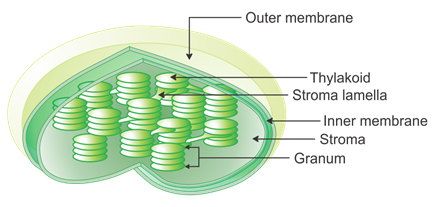
Solution E.4
a. To demonstrate the importance of carbon dioxide in photosynthesis
b. No, the experiment will not work satisfactorily, as the beaker contains lime water and not potassium hydroxide to absorb CO2.
c. Place potassium hydroxide in the beaker instead of lime water
d. Before starting the experiment, it is necessary to destarch the leaves of the plant by keeping the plant in complete darkness for 48 hours. This is because if the plant is not destarched, then the experiment will give false results because starch stored previously may be detected in the leaf placed in the beaker even if no starch is produced during the experiment.
Solution E.5
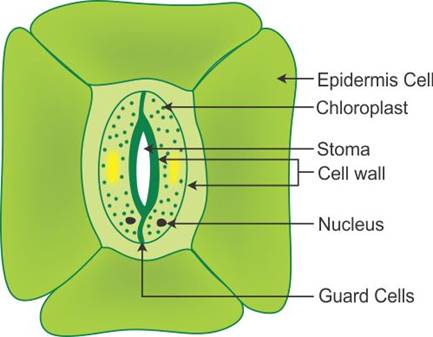
Solution E.6
(a) The main aim of the experiment is to show that oxygen is produced during photosynthesis.
(b) Oxygen gas shown in the experiment comes from photolysis of water in the light reaction of photosynthesis.
(c) The presence of oxygen gas can be confirmed via a glowing splinter test. A glowing splinter bursts into flame indicating the presence of oxygen.
(d) Hydrogen peroxide can be added to water to enhance the process/rate of release of oxygen gas.
(e) Experimental set-up (Initial stage)
